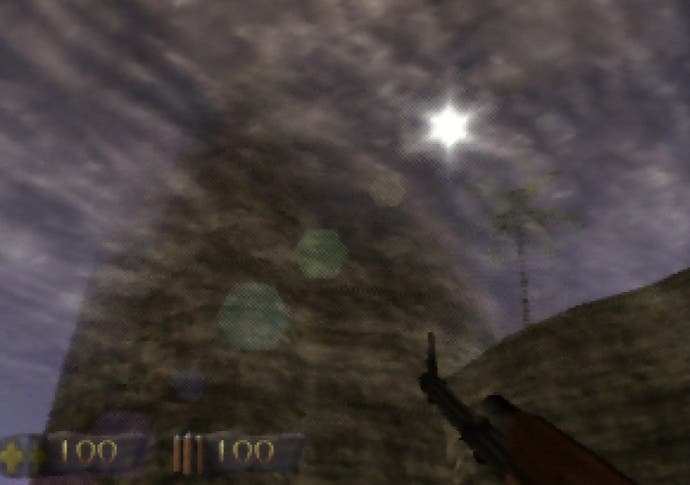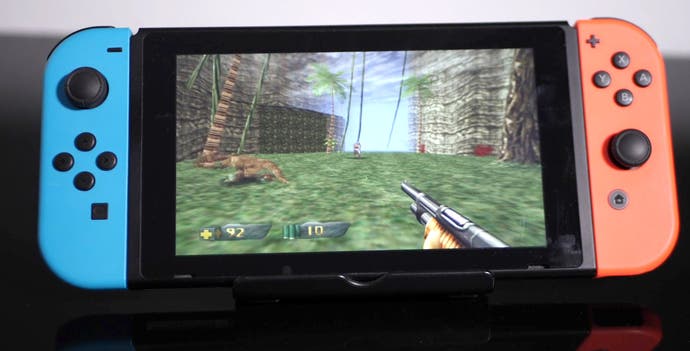DF Retro - how N64's Turok: Dinosaur Hunter was years ahead of its time
Revisiting the 1997 shooter with features even Quake didn't have.
Bungie's Halo or Rare's GoldenEye are often thought of as the first games that truly delivered a technologically advanced, first-class FPS shooter to console platforms - but from my perspective, Iguana Entertainment's Turok: Dinosaur Hunter for N64 may well have got there first. It's a release that was well received at the time but as the years have slipped by, its reputation has slowly lost its lustre, with many suggesting that perhaps Turok was never that impressive or important in the first place.
It's difficult to overstate the hype surrounding Nintendo 64 when it launched in 1996. Boasting 64-bit power and hardware capabilities unlike anything else on the market, it was an instant success. This success was due in no small part to the unrivaled quality of Super Mario 64 which - a release which redefined expectations for what a video game could be. The problem was, very few titles lanched on the system in its first year, resulting in a recurring hype cycle even around the most mediocre of releases.
Turok was far from mediocre though and the hype bordered on the insane, and it's easy to see why. First-person shooters were exploding in popularity on the PC but remained relatively scarce on console platforms. Then there's the violence - Turok delivers a level of carnage and violence at odds with the family-friendly reputation Nintendo had accrued over the years. The large selection of weapons and flying blood particles certainly helped elevate the game's profile. And then there's the technology: Turok was a genuine showpiece with a focus on pyrotechnics and fluid animation quite unlike anything else on the market - even on PC.
Just one example is the world-building: Turok has a persistent world that allows you to double back and visit older areas, and even the very first level offers multiple routes through - a radical departure from the set individual level design of Quake, and this is where our first point on technology comes into play. Turok was developed from the ground-up by Iguana. This is a wholly original project with its own approach to visual design.
The key objective was to deliver a shooter that runs at a reasonably stable frame-rate while offering massive maps to explore in a non-linear fashion. Shooters like Quake relied on binary space partitioning or BSP, while Turok took a completely different approach, relying entirely on static meshes. In a way, this feels almost forward looking!
So what's the difference? With Quake, BSP brushes become the basis of your level - you define shapes and structures via an editor to create your map. With Turok, however, the levels are built entirely from static meshes. This means that floors, walls, the ceiling and other objects are all pre-defined polygonal meshes designed in another program, such as 3D Studio Max. These modelled objects are used construct the maps like Lego pieces, but this also means you cannot define shapes in real-time using the editor as with Quake - if you want a large wall, you'll build it by repeating a wall mesh or combining several different types of walls.
This approach is well suited to creating the massive maps featured in Turok. You basically lay down meshes to build your map - you can copy and paste mesh groups to quickly piece something together too while freely adjusting scale and position. The artists basically create the parts for the map which designers then use to build it and sometimes those parts could be huge - an entire boss room, for instance, could be a single static mesh.
After that, the level designer defines something known as the navigation mesh or nav mesh - basically a collection of convex polygons used to define where players and other moving characters can move. This is the play area. After that, the designer lays down decorative objects, power-ups, enemies and more to construct the flow of the level. Within the N64 itself, all of this is loaded and unloaded at run-time. While you're running around map, the game is constantly loading chunks of the level in and out of memory, based on proximity around the player. Draw distance is historically an issue with this, resulting in Turok's signature fog - but the point is that levels can be absolutely massive, with smooth transitions between any area in the game and no visible load times. Drawbacks? Well, memory is limited, so only a set amount of static meshes can be stored in RAM, meaning a lot of repetition in the level make-up.

Turok pushed hard in other technological directions too, and water rendering is a great example of this. The developers combine a smoothly animated surface texture with transparency and in some cases, an undulating surface mesh. So as you swim, gentle waves are visible across the surface - quite an upgrade from what the likes of Quake were offering at the time. Sky rendering was another standout feature, with clouds that use multiple scrolling transparent layers. And how about lens flare? That's in Turok too. The sun is drawn to the Z buffer and that data is pulled from the GPU where the system can test how occluded the sun is. This data is then used to determine the transparency value for the lens flares.
Turok is also a feast of particles. Particle collision is traced in two dimensions to ensure they behave somewhat naturally while lots of alpha textures are combined to create beautiful plumes of smoke, explosions and blood particles. The larger weapons are rather famous for this and it's another example of a clear improvement compared to the particle system featured in Quake. The N64 hardware itself took care of other problems, such as affine texture warping seen on PS1 games. Everything looked perspective-correct, and there's texture filtering too.
Put simply, beyond the oppressive fog effects, Turok is a supremely impressive example of 3D rendering on a relatively constrained system, but it pushes barriers elsewhere too - specifically in control. Turok solved one of the key issues with first-person shooters on consoles up to this point - aiming. The dual analogue scheme used on modern controllers didn't exist yet, so Iguana assigned free-look to the N64's single analogue stick, while mapping character movement to the C buttons. As a result, you can freely move while independently adjusting your view, enabling things such as circle strafing. Returning to the game today is a treat even on original hardware due to this very forward-looking approach to control.

That said, when people think of Turok, it's usually to complain about the jumping mechanics - and it's a valid complaint, both then and now. Platforming in 3D was still relatively new at the time and doing it in first-person like this with such a new control scheme is asking a lot of players in 1997. However, I feel the issue here is that the platforming asked from the player is too difficult from a design perspective: too many of the jumps are just too far to pull off with much confidence.
Revisiting Turok showcases another key aspect where it was in a class of its own. The animation system really pushes things to the next level, delivering some of the smoothest animation we'd see in any first-person shooter on any platform even years after its release. Compared to its contemporaries though, it was a monumental leap. Firstly, the animation data itself is derived both from motion capture data for human enemies and manual key-framed animation for everything else. Individual characters are constructed from a hierarchy of parts or model pieces that function like a more modern skeleton system - another way in which the game was ahead of its time. The engine then interpolates the results creating smooth blending between each frame. Again, even titles like Quake have no interpolation between animation frames, while many games of this era were still relying on 2D sprites.
A lot of the fluidity in Turok stems from the exceptional animation work itself and there is a lot of artistry here. From the death animations to the impressive running animation - rather than simply spinning around, for instance, there is an animation defined for properly pivoting. You see the enemies shift their weight and change the planting of their feet as they turn around. It's impressive stuff. Related to that, another clever bonus feature is 'Quack' mode - a cheat code that pokes fun at Quake by disabling animation interpolation, particle rendering and texture filtering - key features that set Turok apart from the id software PC powerhouse. It's a fun little bonus for showcasing Turok's innovations, though obviously Quake delivered its own game-changing leaps in FPS technology.

And unlike many console shooters in this difficult transition period from 2D to 3D, performance wasn't bad either. N64 is not known for high frame-rates but Turok fares better than most of its contemporaries. With a target of 30 frames per second - something specified even in the manual - Turok runs reasonably well. It hits its target during normal exploration and light combat but can dip in spots. However, once you obtain larger weapons and explosions start appearing all over the place, frame-rates can dip close to 10fps territory. Still, at least this is short-lived and by and large, performance is good. Indeed, it's a shame that Turok 2 runs so badly by comparison.
A PC version followed, with support for the fledgling Direct 3D and 3DFX's Glide API, but while higher resolutions and cleaner textures were in place, some features were missing or poorly implemented. Many of the visual effects aren't rendered quite right - especially anything involving alpha effects. The fog plane is displayed differently, lens flares from the sun are missing, cloud layers aren't rendered properly and the colours appear somewhat washed out.
This makes the 2015 PC remaster from Nightdive Studios well worth checking out. Programmed primarily by Samuel 'Kaiser' Villareal, this enhanced version of the game is powered by the bespoke KEX engine and offers a whole slew of new visual features, supprting high resolutions and variable aspect ratios along with proper support for modern graphics cards and a full 60 frames per second gameplay. Console versions followed for Xbox One and Switch, both of them also targeting 60fps performance while running at a native 1080p. In the case of the Switch, this applies to docked mode - handheld mode runs at 720p instead.

The PC and Xbox versions do support crepuscular rays, allowing sunlight to beautifully leak around scenery in addition to greatly enhanced water effects with reflection and refraction. Field of view adjustment and increased draw distance is also included. The end result is a level of fluidity, visibility and quality that goes well beyond what was originally possible. Combined with the enhanced controls, this is clearly the best way to enjoy Turok today.
There are some compromises to the Switch port, however. Firstly, features like crepuscular rays are eliminated on Switch due to their high GPU cost. And even removed, there is slowdown on this platform when using the extended draw distance mode which doesn't occur on the other platforms. This comes down to the legacy nature of the engine and the limitations of the low-power Switch hardware. Basically, the primary issue stems from the design of Turok's maps - the level meshes were created with the short view distance in mind and extending the draw distance massively increases the number of draw calls as a result of their fragmentation. Basically, the engine isn't designed to efficiently handle an increased draw distance and the Switch isn't quite strong enough to overcome this.
Regardless, I believe that Turok represents a curious nugget of gaming that combines two things from its era - Quake and Nintendo. It has the fast, skill-driven gameplay and interesting level design of an id Software game from that era while also offering a more exploratory, platform heavy, open-ended Nintendo-style experience that you might find on Nintendo 64. This weird fusion has its flaws but I'd say that it still holds up - even today - and the remasters are an excellent way to experience a game that I genuinely feel is an important chapter in FPS history.


